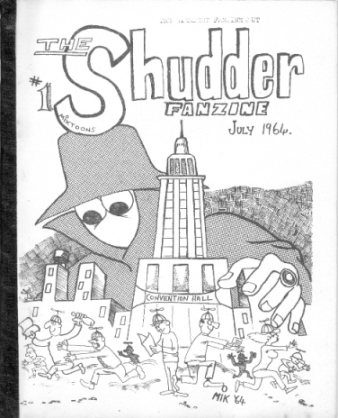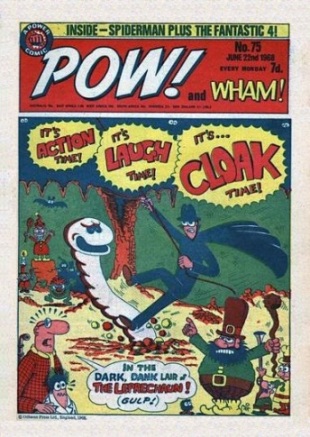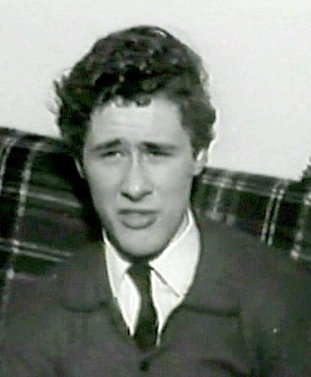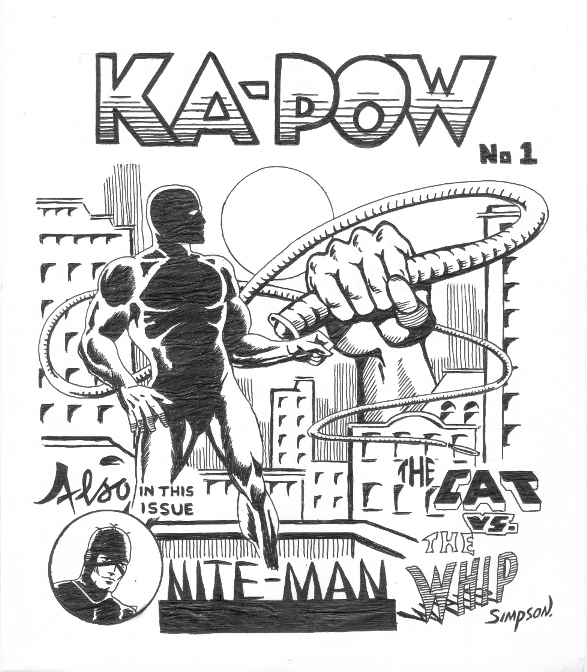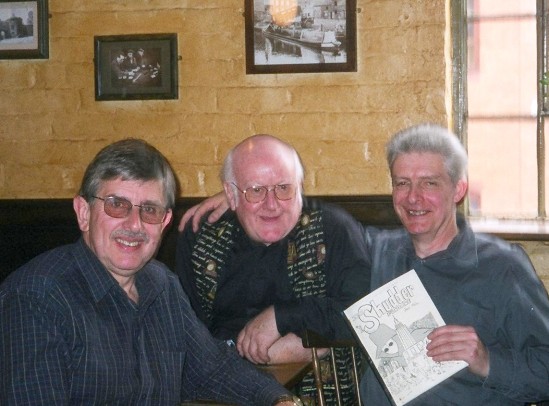COMICS FANDOM: FIRST STIRRINGSThere used to be a saying in science fiction fandom that "it's a proud and lonely thing to be a fan", and for those who imagined themselves the only fan in their location it could be lonely indeed. The birth of the first SF fan groups in the 1930s gradually changed that, but what of comics fans? There's enough of an overlap in interest between the two that SF fandom offered them a home, but it still wasn't comics fandom.In mid-1961 Roger Peyton was a solitary collector who imagined himself to be the only SF enthusiast in Birmingham. Then he encountered Cliff Teague, another SF reader, serving behind the counter of a book stall at New Street Station. The two decided to form a club, the Birmingham Science Fiction Group, and to hold regular Sunday meetings at Teague's place. Expansion was not easy, however, as Peyton recalls:
"Getting new members was a very slow process -- the first was Dave Casey who became a hermit, never leaving his room at home when his parents were rehoused -- he just sat in his room, refusing to talk to anyone, re-reading his Eric Frank Russell books over and over again. Then came Mike Higgs who was more of a comics fan than an SF fan...." Nevertheless, Higgs was soon contributing cartoons to most of the British SF fanzines of the time, signing himself 'Mik'. While there was no comics fandom in the UK for fans to involve themselves in, there was in the US. There had been an earlier fandom in the 1950s devoted to EC comics, but this newer incarnation began when Jerry Bails contacted readers whose letters had appeared in the letter column of DC's 'The Brave and the Bold #35', the first to print readers' full mailing addresses. This was dated Apr/May 1961 but, as was the practice at the time, appeared on the newsstands three months prior to this. Some of those readers were active in SF fandom and put the word out about ALTER EGO. DC comics editor Julius Schwartz loaned Bails his copies XERO, an SF fanzine published by Dick and Pat Lupoff which had recently featured a series of pieces on comics that would later be collected and published as the book 'All In Color For a Dime', and Bails wrote to everyone in their letter column as well. Soon, he was receiving two or three responses daily from people interested in subscribing. The first issue of ALTER EGO appeared in March 1961. Thus was comics fandom born in the US. It would not be surprising if, when fans this side of the Atlantic learned of ALTER EGO and other fanzines that followed in its wake, they wanted to get involved too. In fact it's recently been claimed that one Mark Anthony Warner of Sevenoaks in Kent published SEARCH in May 1963. If true, this would have been the first comics fanzine produced over here, and it being distributed mainly to fans in the US would explain why it remained unknown to comics fans who came later. Nor was the UK the only country where the American example would inspire others, as Dave Gibbons discovered when he found fandom in June 1963:
"It was a letter in the Eagle, which I now got every week that led to my first involvement with fandom The letter was from one John Wright in South Africa, and invited anyone who was interested in collecting comics to order a magazine he was publishing, called THE KOMIX. I wrote off the same day and, seemingly months later, got back a purple-inked mimeograph letter, one side of which was covered with pictures of super-heroes. I sent off an International Money Order and, after weeks of rushing home every day from school in anticipation, finally received the first and second issues of THE KOMIX. I'd only ordered and paid for the current, second issue but, with a generosity that was typical of early fandom, John Wright had sent me one of his remaining copies of #1, too.I was agog at the insight into the history of superhero comics that these issues provided. Most importantly, I realised that there were people out there who were just as enthusiastic about comics as I was. I had discovered my tribe!" A powerful feeling many of us have experienced. Gibbons remained involved for several years, corresponding with American fans and even became a charter member of Jerry Bails' Academy of Comic Book Arts, until one day when...
"...quite suddenly, I lost interest. I shelved my childish hopes of one day working in comics, having become convinced that it was a virtual impossibility for anyone from the Home Counties of England to get work drawing for publishers in New York. Besides, I was now more interested in girls, music and Lambretta scooters." In July 1964, Mike Higgs published the first issue of his fanzine THE SHUDDER, which though an SF fanzine included a text piece on American comics and gags featuring the title character, whose name was an obvious play on 'The Shadow'. The same character - now renamed 'The Cloak' and with the addition of a mouth - would later feature in the comic POW! beginning with issue #18 (w/e 20 May 1967) in stories written and drawn by Mike, and even featured on the cover of some issues. The 1965 Eastercon, the UK national SF convention, was run by the Birmingham Group and Mike was responsible for the Programme Book, which featured a cover and many internal illustrations by him.
But Higgs wasn't the only comics fan in Birmingham looking for others at this time. There was also Phil Clarke, who appeared around 1963 and says of this period:
"In the early '60s I started going down the market, in the city centre - what they called the rag market - which was all second-hand goods and things including two or three comic stalls. There I met a few other people, which was great; they were there every Saturday, I was there every Saturday and we'd go off to a local café and have a chat and then sometimes we'd nip to the news theatre to have a look at the cartoonies. Then in 1964, one of these guys said, he was going down to London to a science fiction meeting. In those days science fiction fandom was big in relation to comic fandom. They had all these meetings and things at people's houses; they stayed overnight and generally they had a fairly good time. So, I joined this guy and we went down to London - hitchhiking in those days....." The person he hitchhiked to London with was Cliff Teague. Their destination was a house (since demolished) on Westbourne Park Road in the Notting Hill area of the capital where Charles Platt then lived. He writes of the place: When my family moved to London... my first priority was to leave home. I signed a lease on a three-story furnished slum in a row of old terrace houses on Westbourne Park Road, in Notting Hill Gate, where rents were cheap because race riots between the Jamaicans and the Irish had stigmatised the area. It appeared rather more glamorous to Clarke (or he has the year wrong - see below):
"Charles Platt, the sci-fi writer, had this lovely house in London - not a big mansion or anything but one of those with the steps up the front that you see. I met a few people there including Steve Moore. I ended up spending most of my time talking to him; mostly about comics in general. He told me there were a lot of comics you couldn't get in the London area, which I thought was amazing because I thought everything was in London. He couldn't find some in London, I couldn't get some in Birmingham, so we said that we'd stay in contact, which you tend to do but never happens, but we did keep in touch. I used to go loads of places with Steve. I'd go down there on the weekend on the train." Born in 1949, Moore and Clarke were both 15 years old when they met, and their friendship would prove a significant factor in getting comics fandom in the UK started a few years later. As for exactly when their first meeting took place, Charles Platt - who was still a fan at this point - moved into his Notting Hill flat in September 1964 and stayed there through to mid-February 1965, when he relocated to Hampstead, as recorded by contemporary change of address notices in SKYRACK. The housewarming party at his new place on the 27th of that month that Cliff Teague was once again at also attracted SF pros John Brunner, Michael Moorcock and J.G. Ballard. At this point, Platt was publishing the fanzine BEYOND which, as well as featuring Mike Higgs cartoons in its pages, often sported covers by Dicky Howett. The seventh issue, in October 1964, included an article by Roy Kay on Marvel comics. The next development was the appearance in autumn 1964 of the first Newsletter of the Dan Dare Club, produced by Eric MacKenzie and Andrew Skilleter, then aged 15 and 16 years old respectively. As to how the club came about, Skilleter recalls,
" It was heading for the mid 1960s, I was captivated at the time by the way Dan Dare was re-energised by Keith Watson's art and David Motton's storylines. I was a huge fan of Keith's art and then along came "All Treens Must Die" in 1964 which was the icing on the cake. Dan back in two pages of colour with the Mekon, Treens, Venus and the Anastasia. It was simply fantastic at the time and it was this that inspired me to do something. I guess there must have been other factors but I can't recall the sequence of events. Certainly Eric MacKenzie got in touch but I imagine we must have formed the Club together. We were certainly ignited by the some passion. Robert (Bob) Bartholomew and later the Eagle staff were supportive and unbelievably printed a nice little plug for DDC on Eagle's letters page!" In its initial form The Dan Dare club newsletter saw six issues, the final one dated September 1965. Exchange and Mart appeared weekly between 1868 and 2009 and was the first publication in the world dedicated to classified ads. It was a very cheap way of advertising your wares nationally, and numerous people including Dez Skinn and Frank Dobson began selling comics through its pages. At some point in 1965, Dobson created his own adzine for comics fans, FANTASY ADVERTISER. Though it was duplcated on quarto paper, usually with what appear to be lithoed card covers featuring artwork by people like Steve Moore, it was initially just a sales list and wouldn't develop into a true fanzine until later. LONCON II, the 1965 World Science-Fiction Convention, took place over the 27th/30th August weekend in the Mount Royal Hotel, Marble Arch, London. It was only the second to be held outside the North American continent, the first being the 1957 Worldcon which had also been held in London, at a hotel barely a mile away from this one. Some 350 people attended, including Steve Moore, Phil Clarke, Mike Higgs, Stan Nicholls, and Derek 'Bram' Stokes. Meeting other comics fans would prove decisive. Explains Clarke:
"From there, it started to build slow but sure until '66-67, which was the sort of fanzine era. Steve got himself a spirit duplicator, which was his pride and joy. He churned out loads of things on it." This included three or more issues of his SF fanzine VEGA, at least one of which was distributed through PADS, the British Science Fiction Association's pseudo-APA.
In January 1966 the Dan Dare Club newsletter relaunched as "ASTRAL — the Journal of the International Dan Dare Club. Following the six issues of the original Newsletter, this second volume of publications saw eleven issues to September 1966. ASTRAL volume 3 began in December and would run monthly for a dozen issues before ASTRAL ceased publication with the November 1967 issue. There would be a four issue revival of ASTRAL as a fanzine in 1970/71, but with no new Dan Dare material being produced interest waned and the club faded away. In January 1967, Bram Stokes launched his mail order business 'Vault of Horror', which would eventually become 'Dark They Were and Golden Eyed'. (The story behind this and the start of comics shops in London is covered in detail by Stan Nicholls in his excellent piece in PROLAPSE #11.) Around this same time up in Harrogate, SF fan Ron Bennett was contemplating his future. In his long-running SF newszine SKYRACK (full collections of which are available as web pages and as a free ebook), he would soon announce:
"As some readers will know I have of late been trying to establish myself as a book and magazine dealer. Because of an impending move which involves a new job working for the Ministry of Defence I hope to be in a position whereby I will be able to obtain material not usually freely circulated in this country, particularly American pulps and older magazines and pocketbooks. If there is any item for which you'd like me to keep an eye open on your behalf do please let me have your want lists. There will of course be no obligation to buy, you’ll merely have first refusal on any such material obtained. Collections purchased. Trades welcome." Though his initial intent was clearly to focus on SF, Bennett soon found a source of cheap comics following his move to Singapore and quickly started listing these for sale in the pages of FANTASY ADVERTISER. (His account of his travails can now be found on this site at the link below.) And so all the pieces were finally in place for a fandom dedicated to comics to form on this side of the Atlantic. All that was missing was the initial spark, a spark that would soon be supplied by people already toiling away on comiczines in Birmingham, London, and Dublin....
...Rob Hansen, August 2018. Further reading:
| ||||||||
|
